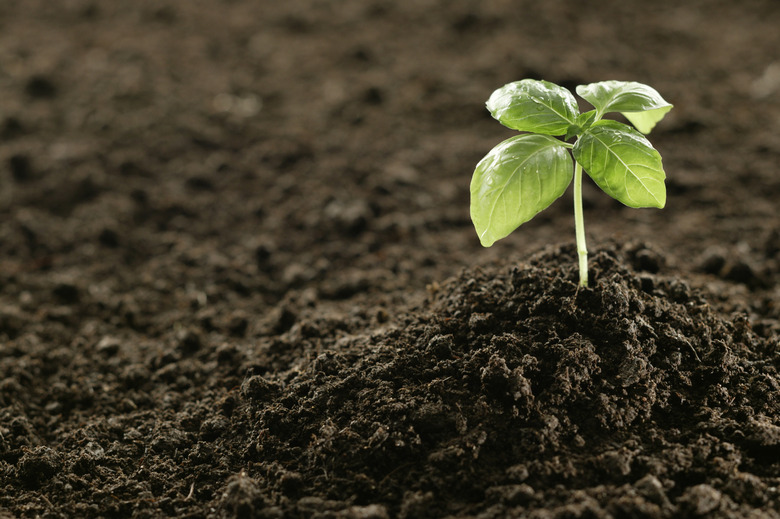How Does Sediment Affect The Ecosystem?
Sediment – the tiny particles produced by the rotting and erosion of rock and the breakdown of organic matter and transported by wind, water and glacial ice – isn't always a very conspicuous component of an ecosystem. It's not like the large-scale elements of the physical landscape – mountain peaks, river canyons – that serve as the stage, or the biological players – soaring trees, flashy animals – weaving together its food web. But these sands, silts and clays serve as building blocks of soils and landforms alike, transport nutrients, facilitate chemical reactions and otherwise help shape an ecosystem's physical environment and biological processes alike.
Sediments as Raw Materials for Rocks and Landforms
Sediment such as sand or mud deposited, for example, in a river delta or a seafloor may become deeply buried – enough so that high pressure cements the particles together and turns them into rock: sedimentary rock, to be exact, such as sandstone or mudstone. This rock then plays a fundamental role in ecosystems, serving as a "parent material" for soil development, for example, or – when exposed at the surface – creating bedrock terrain that helps create habitat.
Sediment doesn't need to turn into rock to produce landforms, either: a delta and seafloor are built from sediment, as are the alluvial plains of a river valley, dunes formed by windblown sand and mudbanks, sandbars and barrier islands, to name a few examples. Wetlands help slow the process of erosion by trapping sediments washed into rivers, which then drop some of this load of particles when they spill into floodplain marshes or swamps, or spread out in coastal marsh/estuary complexes.
Sediment and Nutrients
Sediment in both inorganic and organic form affects the availability of nutrients in aquatic ecosystems. Nutrients such as phosphorus and nitrogen may bond to sediment (both suspended in the water column and deposited as "bedload") through adsorption, or diffuse into it; such sediment-bound nutrients can also be released by desorption or by diffusion. This exchange between sediment and water – resulting from many different triggers, including the pH and the concentration of molecules – can make nutrients available or unavailable to organisms, and also shapes the chemical characteristics of the aquatic environment. This helps determine how favorable or unfavorable the environment is as habitat to a particular life form.
Sediment Contributions to Soil
Whether deposited by floodwaters, wind or other agents, sediment provides a base material for soils, impacts soil texture and thus greatly influences soil chemistry and water capacity. Windblown sediment – such as silt-sized loess and volcanic ash – is fine-textured and can improve the nutrient- and water-holding capacity of soils where it's deposited. Tiny fragments of clay and organic humus less than a tenth of a micrometer in size called colloids bond to nutrients and thus keep them from being leached out of soil; they also provide an important site for the chemical reactions that help drive soil processes, and improve water retention.
Impacts of Too Much or Too Little Sediment, and of Sediment Water Pollution
The amount, texture and chemistry of sediment inputs can have a huge influence on aquatic ecosystems. Even essential nutrients that are required by organisms can have negative impacts when released from sediment in excessive quantities. Large amounts of suspended sediment can turn waters murky, limiting light transmission and changing the temperature, while heavy accumulations of sediment can diminish water depth (which also changes its temperature and otherwise greatly alters the aquatic environment). High volumes of sediment released from rivers into coastal waters can choke seagrass beds, coral reefs and other sensitive marine habitats.
Sediment "overloads" in watersheds may result from natural events such as torrential storms, mudflows and volcanic eruptions; the May 1980 eruption of Mount St. Helens in the Washington Cascades, for example, boosted suspended sediment in the North Fork Toutle River by some 500 times. Human activity is another major source of sedimentation; enhanced erosion and runoff from roads and plowed fields can greatly increase a river basin's sediment quantity. Too little sediment also impacts ecosystems. Human modifications of rivers, including dams and channelization, can reduce their sediment load, which diminishes the natural formation of sandbars, deltas, beaches and other depositional landforms downstream and also may lessen nutrient availability.
Sediment water pollution, meanwhile, can result when pesticides, toxins and other chemicals bind to clay and silt particles washed into drainages from agricultural, industrial and residential sources.
References
- U.S. Environmental Protection Agency: Impacts of Sediment & Nutrients on Biota in Surface Waters of the United States
- Physical Geography: A Landscape Appreciation; Tom L. McKnight et al.
- Ecological Responses to the 1980 Eruptions of Mount St. Helens; Virginia H. Dale et al. (eds)
- USDA Natural Resources Conservation Service: Effects of Sediment on the Aquatic Environment
Cite This Article
MLA
Shaw, Ethan. "How Does Sediment Affect The Ecosystem?" sciencing.com, https://www.sciencing.com/sediment-affect-ecosystem-6772/. 19 August 2018.
APA
Shaw, Ethan. (2018, August 19). How Does Sediment Affect The Ecosystem?. sciencing.com. Retrieved from https://www.sciencing.com/sediment-affect-ecosystem-6772/
Chicago
Shaw, Ethan. How Does Sediment Affect The Ecosystem? last modified August 30, 2022. https://www.sciencing.com/sediment-affect-ecosystem-6772/
